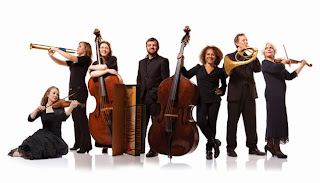A visit to the Pieta, music by Vivaldi and Porpora
Schola Pietatis Antonio Vivaldi, Orchestra of the Age of Enlightenment, Kati Debretzeni
London Festival of Baroque Music at St John's Smith Square
Reviewed by Robert Hugill on May 17 2015, Star rating:
Re-creating Vivaldi's sound-world with an all-female choir
London Festival of Baroque Music continued its exploration of women as composers, performers and inspirers of Baroque music with A Visit to the Pieta at St John's Smith Square on Sunday 17 May 2015, when the Schola Pietatis Antonio Vivaldi (aka Vivaldi's Women) and the Orchestra of the Age of Enlightenment, directed from the violin by Kati Debretzeni, performed a programme of music by Vivaldi and Nicola Porpora. The music was written for the Pieta, the ospedale in Venice which took foundlings. Boys were trained for a job in the wider world, but girls either married or stayed on, so musical training gave them a suitable occupation, and the choir and orchestra became famous.
Schola Pietatis Antonio Vivaldi, Orchestra of the Age of Enlightenment, Kati Debretzeni
London Festival of Baroque Music at St John's Smith Square
Reviewed by Robert Hugill on May 17 2015, Star rating:
Re-creating Vivaldi's sound-world with an all-female choir
 |
| Schola Pietatis Antonio Vivaldi |
 |
| Kati Debretzeni |
 |
| Orchestra of the Age of Enlightenement |
Vivaldi's Dixit Dominus RV595 is an early work written for the Pieta, and it is not in the Vivaldi archive in Turin, it survives only in parts copied in the 18th century. It is very like the Gloria in its large scale combination of chorus and soloists. With the soloists coming out of the choir, different ones for each number, it made a great deal of sense of the profligate way Vivaldi seemed allocate solos. Dixit Dominus opened with a trumpet gesture leading into a lively full ensemble and it was clear that Kati Debretzeni's speeds were going to be on the brisk side, but they never felt over done or driven. Interleaving massive choral movements with more intimate solos, the work included such notable moments as the duet Tecum principium where two soprano soloists were supported by duetting cellos in ravishing fashion.
 |
| Ospedale della Pieta in Venice |
The first half finished with the Concerto in D major, for violin, strings and continuo, 'a due cori' RV582 ‘per la Santissima Assontione di Maria Vergine'. It is one of a group of works written for Anna Maria (1696-1782), the concerto uses two string orchestra and Vivaldi had great fun playing one against the other. In the opening Allegro, strong tutti moments punctuated Kati Debretzeni's fast and furious playing of the solo violin part. The Largo was slower, with a more lyrical solo violin over spare unison strings. The concluding Allegro combined vigorous repeated notes in the strings with busy string crossing in the solo part, as well as a stratospheric cadenza. Throughout Kati Debretzeni combined superb technical skill and great charm, with directing the orchestra.
After the interval we heard another Vespers psalm setting, Laetatus sum by Nicola Porpora who was choirmaster at the Pieta in the1740's. Again written for two orchestras, with a matching double choir, Nicola Porpora used solos extensively, punctuating these with a tutti refrain in which he made the most of the rich textures possible with two choirs. It made for a striking and rather appealing work. Vivaldi's Nulla in mundo pax sincera RV630 is one of the most familiar of his solo motets. Consisting of a lyrically melodic siciliana-like Larghetto and a toe-tapping Allegro with a bravura concluding Alleluia, it was neatly sung by Penelope Martin-Smith.
The final work in the programme was Vivaldi's Gloria RV589, with the all-female choral forces shedding interesting sidelight on the work and a team of singers providing varied solo contributions. Kati Debretzeni opened the work at quite a lick, but chorus and orchestra followed her and the result was invigorating. The material, and the tempo, returned at the end, but in between there were more relaxed moments such as the lilting soprano solo Domine Deus with its lilting oboe solo.
There has been a tendency for period performance to frequently ignore the vocal contributions, pairing rigorous period instrumental technique with singers with very modern vocal techniques. The Schola Pietatis Antonio Vivaldi is thus a valuable step in helping us to understand the very particular sound-world for which Vivaldi's sacred music at the Pieta was written. But this concert was far more than a dull academic recreation. The choir made an interesting, vital choral sound and the women were clearly enjoying themselves. The whole performance had an infectious vibrancy from choir and orchestra, with some superb individual solo contributions from the orchestra. Kati Debretzeni is supremely impressive, combining the tasks of directing choir and orchestra, as well as playing, all with charm and aplomb.
The concert was broadcast on BBC Radio 3 and will be available on-line for 30 days.
Elsewhere on this blog:
- Post-minimal modes: Michael Vincent Waller - CD review
- Day two, Baroque women as performers and composers: London Festival of Baroque Music - concert review
- London Festival of Baroque Music: Bach Collegium Japan - concert review
- Tintinnabuli: The Tallis Scholars in concert - concert review
- Keeping the balance: Iestyn Morris talks about Peter Pan - interview
- Vital and engaging: Rachel Podger and Brecon Baroque - concert review
- Straight or swung? Cole Porter songbook - CD review
- Interesting mix: guitarist Christina Sandsengen's Shades and Contrasts - CD review
- Discovering new territories: Carolyn Sampson and Joseph Middleton Fleurs - CD review
- Blowing away the blues: Alison Balsom, Lucy Crowe, Tim Mead, Trevor Pinnock, the English Concert and Tom Green Septet - concert review
- Handel's favourite tenor: Allan Clayton and Classical Opera - concert review
- Richness restores: Donizetti's Les Martyrs - CD review
- Rattling good tale: Shackleton's Cat - opera review
- Home



%20Ali%20Wright.jpg)
.jpg)


%20Ali%20Wright.jpg)

%20and%20Hanna%20Hipp%20(Dinah)%20Credit_%20Genevieve%20Girling%20(4).jpg)

No comments:
Post a Comment